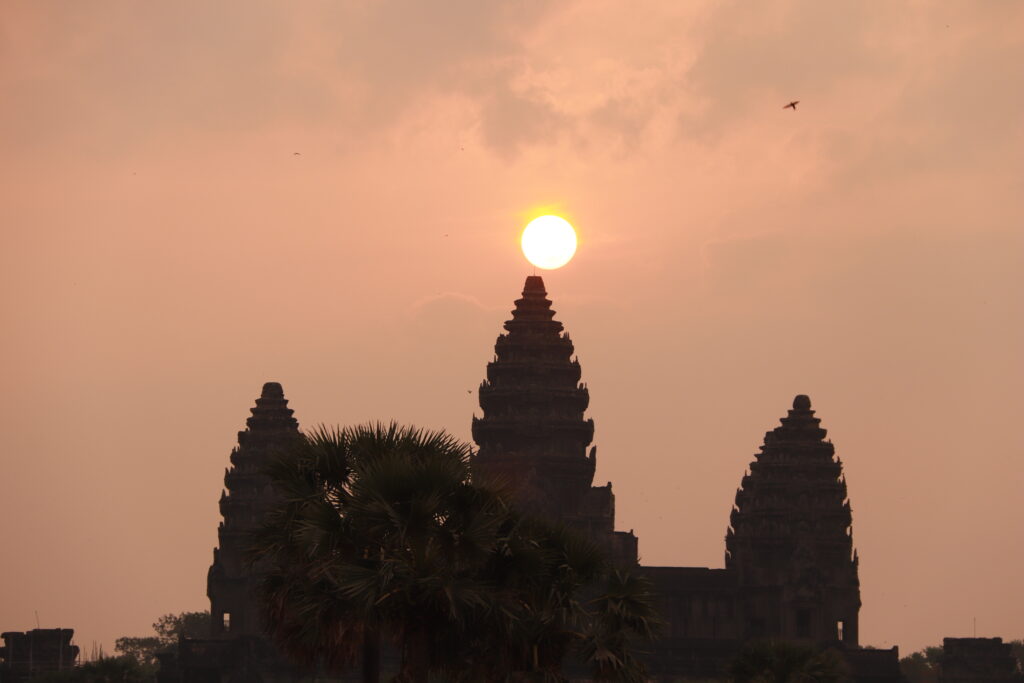យើងស្គាល់សមរាត្រី តាមការប្រែសម្រួលពីភាសាសំស្ត្រឹត ដែលមានសរសេរលើថ្មបុរាណតាំងពីសម័យមុនអង្គរ និងសម័យអង្គរ ថា “វិសុវ” (បើសរសេរតាមភាសាបច្ចុប្បន្ន ជា “ពិសុព”) ដែលប្រាជ្ញខាងសិលាចារឹកបានដឹងឮយូរមកហើយដែរ។ សមរាត្រី (វិសុវ/ពិសុព) ជាព្រឹត្តិការណ៍មួយ ដែលរយៈពេលថ្ងៃនិងយប់មានប្រវែងស្មើគ្នា។ ជាពិសេសចំពោះអង្គវត្តក្នុងវេលាថ្ងៃនេះ នាវេលាព្រឹកស្រាងៗ មានព្រះអាទិត្យរះចំកណ្តាលកំពូលប្រាសាទ បើគិតនៅឆ្នាំ២០២៣ ត្រូវចំនៅថ្ងៃទី២១ ខែមីនា ខាងមុខនេះ។
សមរាត្រី (Equinox) កើតឡើងចំនួន២ដងជារៀងរាល់ឆ្នាំ គឺសមរាត្រីរដូវប្រាំង (វសន្តរដូវ) កើតឡើងនៅថ្ងៃទី២១ ខែមីនា និងសមរាត្រីរដូវវស្សាកើតឡើងនៅថ្ងៃទី២២ ខែកញ្ញា។
លោក អ៊ឹម សុខរិទ្ធី បុរាណវិទូ និងជាប្រធាននាយកដ្ឋានស្រាវជ្រាវ បណ្តុះបណ្តាល និងផ្សព្វផ្សាយ នៃអាជ្ញាធរជាតិអប្សរាមានប្រសាសន៍ថា ព្រឹត្តិការណ៍ពិសេសនេះ នាវសន្តរដូវ ប្រហែលមានប្រារព្ធកិច្ចពិធីធំៗតាមទំនៀមព្រាហ្មណ៍នាសម័យអង្គរ។ ប៉ុន្តែពិធីទាំងនោះ មិនមានបន្តរៀបចំមកទល់សព្វថ្ងៃ នាំឲ្យយើងបាត់ដានឈឹង។ ដើម្បីជាការពិចារណា យើងសាកល្បងមើលទៅប្រភពដើមនៃអារ្យធម៌ខ្មែរ ដ្បិតយើងទទួលឥទ្ធិពលពីឥណ្ឌា ហើយប្រហែលតិចឬច្រើនយើងប្រតិបត្តិតាមប្រពៃណីព្រាហ្មណ៍ខ្លះហើយ។
នាថ្ងៃវិសុវ/ពិសុព វសន្តរដូវ ទី១ ព្រាហ្មណ៍នៅទូទាំងប្រទេសឥណ្ឌានៅអំឡុងខែមីនា គេឃើញមានប្រារព្វពិធីបុណ្យមួយយ៉ាងធំ បើតាមគម្ពីបុរាណរបស់ឥណ្ឌា គេហៅថា Holi។ នៅក្នុងពិធីនេះ អ្នកចូលរួមទាំងអស់បានច្រៀង រាំ យ៉ាងត្រេកអរ ដោយយកម្សៅពណ៌មកបាចនិងលាបដាក់គ្នាទៅវិញទៅមកយ៉ាងសប្បាយរីករាយដើម្បីអបអរសារទជ័យជំនៈរបស់ព្រះនរាយណ៍ដែលបានតំណែងខ្លួនជាអាវតារមានទម្រង់ជានរសឹង្ហ ដែលបានសម្លាប់យក្សកំណាចដ៏ធំមួយ បានបំផ្លាញផែនដីមានឈ្មោះថា ហិរណ្យកស៊ីពុ ( Hiranyakashipu)។ ទី២ ព្រឹត្តិការណ៍សមរាត្រីនេះអាចជាប់ពាក់ព័ន្ធនឹងរឿងជ័យជំនះរបស់ព្រះនរាយណ៍ដែរ គឺព្រះគ្រឹស្ណដែលជាអាវតារមួយយ៉ាងសំខាន់របស់ព្រះអង្គដែលបានកំចាត់ ឬបំផ្លាញសភាវអាក្រក់។ ព្រាហ្មណ៍ ប្រារព្ធកិច្ចដើម្បីបង្ហាញថា សភាវល្អឈ្នះលើសភាវអាក្រក់ យុត្តិធម៌ឈ្នះលើអយុត្តិធម៌។ ទី៣ ថ្ងៃវិសុវ/ពិសុពនេះក្រៅពីជាប់ពាក់ព័ន្ធនឹងរឿងថ្ងៃមង្គលរបស់និកាយព្រះនរាយណ៍ ក៏ជាថ្ងៃមង្គលធំមួយរបស់និកាយព្រះឥសូរដែរ។ វេលាថ្ងៃនិងយប់មានរយៈពេលស្មើគ្នានេះ ព្រះឥសូរនិងមហេសីបានរួមបញ្ចូលគ្នាជាប្រាណតែមួយ ដែលមួយចំហៀងជាប្រាណបុរស និងមួយចំហៀងជាប្រាណស្រ្តី ដែលមានឈ្មោះថា “អឌ្ឍនារីស្វរ” (Ardhanarishvara)។ ខ្មែរបុរាណនិយមបដិមានេះខ្លាំង ដែលយើងមានបដិមានេះនៅមុនសម័យអង្គរនិងសម័យអង្គរ។
ទី៤ ចំពោះប្រពៃណីធ្វើយោគ (Yogic tradition) នៅថ្ងៃសមរាត្រីរដូវនេះ គឺជាថ្ងៃដ៏វិសេសសម្រាប់អ្នកប្រតិបត្តិយោគ (Yoga) ព្រោះជាពេលវេលាដ៏ល្អបំផុត ដើម្បីទទួលផលខ្ពង់ខ្ពស់ ពីការធ្វើយោគ ជាងវេលាណាៗទាំងអស់។
បើពិចារណាលើករណីពិធីខាងលើ នោះយើងឃើញមានទាក់ទងនឹងព្រះនរាយណ៍ជាពិសេស។ អង្គរវត្តសាងទ្បើងជាទេវឋានរបស់ព្រះនរាយណ៍ មានឈ្មោះដើមថា “ព្រះបរមវិស្ណុលោក”។ តើថ្ងៃរះចំកំពូលកណ្តាលអង្គរវត្តនៅសមរាត្រីរដូវប្រាំងនេះ មានទាក់ទងនឹងកិច្ចពិធីខាងលើទេដឹង?
អត្ថបទ៖ ឆាយ ផាន់នី
រូបភាព៖ លោក ហ៊ុ រិទ្ធី
We know the equinox event from a translation of the Sanskrit language, which was written on the ancient stone from pre-Angkorian and Angkorian times, which simply means that the duration of day and night is equal and the sun rises exactly over the central peak of Angkor Wat on 21 March 2023.
The equinox occurs twice a year, the dry season equinox occurs on 21 March and the rainy season equinox occurs on 22 September.
Im Sokrithy, an archaeologist and director of the Department of Research, Training, and Communication of the APSARA National Authority, said that this special event may be celebrated the Brahmin tradition during the Angkorian period. But those ceremonies did not continue to be organized until today, leading us to disappear. For consideration, we try to look at the origins of Khmer civilization, as we are influenced by India and perhaps more or less we practice some Brahmin tradition.
During the dry season equinox in March, first, Brahmins from all over India, a large festival observed according to the ancient Indian scriptures called Holi. In this ceremony, all the participants sang and danced happily, sprinkling colored powder and painting each other to celebrate the victory of Narayana, who took the form of a lion that killed a giant named Hiranyakashipu. Second, this event may be related to the story of the victory of Narayana, Krishna, one of his most important avatars, who eliminated or destroyed evil. Brahmins celebrate to show that good nature overcomes evil, and injustice. Third, not only related to the happy day of the Narayana but also one of the great happy days of the Shiva. During day and night is equal, the Shiva and his wife fused into one body, called “Ardhanarishvara”. Khmer indeed worshiped this god form that we had this statue before the Angkorian and during Angkorian eras.
Fourth, for the Yogic tradition, this auspicious day of the season, is a special day for yoga practitioners because it is the best time to get the benefits of yoga more than ever.
Considering the case of the above ceremonies, we see that the equinox event must be related to Narayana in particular. Angkor Wat was built as a shrine of Narayana, originally named “Parama Vishnuloka”. Do you think the sunrise at the top of Angkor Wat in the dry season is related to the above ceremonies?
Article: Chhay Phanny
Photo: Mr. Hum Rithy
Share:
Our Latest News

អាជ្ញាធរជាតិអប្សរា រៀបចំកម្មវិធីបណ្ដុះគំនិតកុមារចេះថែរក្សាបរិស្ថានក្នុងតំបន់អង្គរ- APSARA National Authority organizes an environmental training program for children in the Angkor site- 29 May 2025
ថ្ងៃទី២៩ ខែឧសភា ឆ្នាំ២០២៥ អង្គភាពប្រព័ន្ធគ្រប់គ្រងបរិស្ថានអង្គរនៃអាជ្ញាធរជាតិអប្សរា សហការជាមួយសាលាបឋមសិក្សាចំនួន៣ មានសាលាបឋមសិក្សាដូនឪ សាលាបឋមសិក្សាត្រពាំងស្វាយ សាលាបឋមសិក្សាគោកគ្រើល ស្ថិតក្នុងស្រុកអង្គរធំ ខេត្តសៀមរាប




